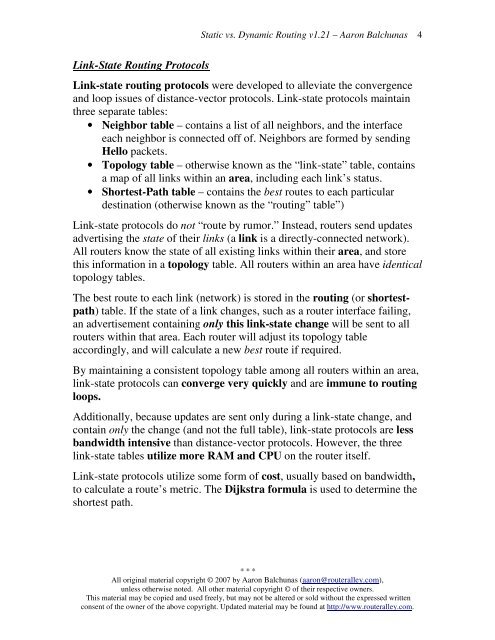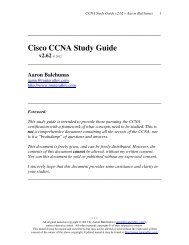Static vs. Dynamic Routing - Router Alley
Static vs. Dynamic Routing - Router Alley
Static vs. Dynamic Routing - Router Alley
Create successful ePaper yourself
Turn your PDF publications into a flip-book with our unique Google optimized e-Paper software.
<strong>Static</strong> <strong>vs</strong>. <strong>Dynamic</strong> <strong>Routing</strong> v1.21 – Aaron Balchunas<br />
4<br />
Link-State <strong>Routing</strong> Protocols<br />
Link-state routing protocols were developed to alleviate the convergence<br />
and loop issues of distance-vector protocols. Link-state protocols maintain<br />
three separate tables:<br />
• Neighbor table – contains a list of all neighbors, and the interface<br />
each neighbor is connected off of. Neighbors are formed by sending<br />
Hello packets.<br />
• Topology table – otherwise known as the “link-state” table, contains<br />
a map of all links within an area, including each link’s status.<br />
• Shortest-Path table – contains the best routes to each particular<br />
destination (otherwise known as the “routing” table”)<br />
Link-state protocols do not “route by rumor.” Instead, routers send updates<br />
advertising the state of their links (a link is a directly-connected network).<br />
All routers know the state of all existing links within their area, and store<br />
this information in a topology table. All routers within an area have identical<br />
topology tables.<br />
The best route to each link (network) is stored in the routing (or shortestpath)<br />
table. If the state of a link changes, such as a router interface failing,<br />
an advertisement containing only this link-state change will be sent to all<br />
routers within that area. Each router will adjust its topology table<br />
accordingly, and will calculate a new best route if required.<br />
By maintaining a consistent topology table among all routers within an area,<br />
link-state protocols can converge very quickly and are immune to routing<br />
loops.<br />
Additionally, because updates are sent only during a link-state change, and<br />
contain only the change (and not the full table), link-state protocols are less<br />
bandwidth intensive than distance-vector protocols. However, the three<br />
link-state tables utilize more RAM and CPU on the router itself.<br />
Link-state protocols utilize some form of cost, usually based on bandwidth,<br />
to calculate a route’s metric. The Dijkstra formula is used to determine the<br />
shortest path.<br />
* * *<br />
All original material copyright © 2007 by Aaron Balchunas (aaron@routeralley.com),<br />
unless otherwise noted. All other material copyright © of their respective owners.<br />
This material may be copied and used freely, but may not be altered or sold without the expressed written<br />
consent of the owner of the above copyright. Updated material may be found at http://www.routeralley.com.

















